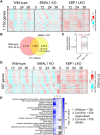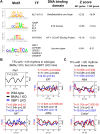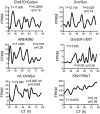Preservation of ∼12-h ultradian rhythms of gene expression of mRNA and protein metabolism in the absence of canonical circadian clock
- PMID: 37324401
- PMCID: PMC10267751
- DOI: 10.3389/fphys.2023.1195001
Preservation of ∼12-h ultradian rhythms of gene expression of mRNA and protein metabolism in the absence of canonical circadian clock
Abstract
Introduction: Besides the ∼24-h circadian rhythms, ∼12-h ultradian rhythms of gene expression, metabolism and behaviors exist in animals ranging from crustaceans to mammals. Three major hypotheses were proposed on the origin and mechanisms of regulation of ∼12-h rhythms, namely, that they are not cell-autonomous and controlled by a combination of the circadian clock and environmental cues, that they are regulated by two anti-phase circadian transcription factors in a cell autonomous manner, or that they are established by a cell-autonomous ∼12-h oscillator. Methods: To distinguish among these possibilities, we performed a post hoc analysis of two high temporal resolution transcriptome dataset in animals and cells lacking the canonical circadian clock. Results: In both the liver of BMAL1 knockout mice and Drosophila S2 cells, we observed robust and prevalent ∼12-h rhythms of gene expression enriched in fundamental processes of mRNA and protein metabolism that show large convergence with those identified in wild-type mice liver. Bioinformatics analysis further predicted ELF1 and ATF6B as putative transcription factors regulating the ∼12-h rhythms of gene expression independently of the circadian clock in both fly and mice. Discussion: These findings provide additional evidence to support the existence of an evolutionarily conserved 12-h oscillator that controls ∼12-h rhythms of gene expression of protein and mRNA metabolism in multiple species.
Keywords: Drosophila S2 cell; X-box binding protein 1 (XBP1); mRNA metabolism; proteostasis; ultradian and circadian rhythms.
Copyright © 2023 Zhu and Liu.
Conflict of interest statement
The authors declare that the research was conducted in the absence of any commercial or financial relationships that could be construed as a potential conflict of interest.
Figures






Update of
-
Preservation of ∼12-hour ultradian rhythms of gene expression of mRNA and protein metabolism in the absence of canonical circadian clock.bioRxiv [Preprint]. 2023 May 2:2023.05.01.538977. doi: 10.1101/2023.05.01.538977. bioRxiv. 2023. Update in: Front Physiol. 2023 May 30;14:1195001. doi: 10.3389/fphys.2023.1195001. PMID: 37205336 Free PMC article. Updated. Preprint.
Similar articles
-
Preservation of ∼12-hour ultradian rhythms of gene expression of mRNA and protein metabolism in the absence of canonical circadian clock.bioRxiv [Preprint]. 2023 May 2:2023.05.01.538977. doi: 10.1101/2023.05.01.538977. bioRxiv. 2023. Update in: Front Physiol. 2023 May 30;14:1195001. doi: 10.3389/fphys.2023.1195001. PMID: 37205336 Free PMC article. Updated. Preprint.
-
Multiscale Time-resolved Analysis Reveals Remaining Behavioral Rhythms in Mice Without Canonical Circadian Clocks.J Biol Rhythms. 2022 Jun;37(3):310-328. doi: 10.1177/07487304221087065. Epub 2022 May 16. J Biol Rhythms. 2022. PMID: 35575430 Free PMC article.
-
Revealing the hidden reality of the mammalian 12-h ultradian rhythms.Cell Mol Life Sci. 2021 Apr;78(7):3127-3140. doi: 10.1007/s00018-020-03730-5. Epub 2021 Jan 15. Cell Mol Life Sci. 2021. PMID: 33449146 Free PMC article. Review.
-
12-h clock regulation of genetic information flow by XBP1s.PLoS Biol. 2020 Jan 14;18(1):e3000580. doi: 10.1371/journal.pbio.3000580. eCollection 2020 Jan. PLoS Biol. 2020. PMID: 31935211 Free PMC article.
-
Circadian Rhythms and Sleep in Drosophila melanogaster.Genetics. 2017 Apr;205(4):1373-1397. doi: 10.1534/genetics.115.185157. Genetics. 2017. PMID: 28360128 Free PMC article. Review.
Cited by
-
Biological rhythms: Living your life, one half-day at a time.NPJ Biol Timing Sleep. 2025;2(1):21. doi: 10.1038/s44323-025-00037-1. Epub 2025 Jun 3. NPJ Biol Timing Sleep. 2025. PMID: 40475272 Free PMC article. Review.
-
Autonomous Oscillatory Mitochondrial Respiratory Activity: Results of a Systematic Analysis Show Heterogeneity in Different In Vitro-Synchronized Cancer Cells.Int J Mol Sci. 2024 Jul 16;25(14):7797. doi: 10.3390/ijms25147797. Int J Mol Sci. 2024. PMID: 39063035 Free PMC article.
-
SON-dependent nuclear speckle rehabilitation alleviates proteinopathies.Nat Commun. 2025 Aug 5;16(1):7065. doi: 10.1038/s41467-025-62242-7. Nat Commun. 2025. PMID: 40764481 Free PMC article.
-
Re-scoping ultradian rhythms in the context of metabolism.Front Physiol. 2024 Dec 12;15:1504879. doi: 10.3389/fphys.2024.1504879. eCollection 2024. Front Physiol. 2024. PMID: 39737341 Free PMC article.
-
Basic research and opportunities for translational advancement in the field of mammalian ∼12-hour ultradian chronobiology.Front Physiol. 2024 Nov 20;15:1497836. doi: 10.3389/fphys.2024.1497836. eCollection 2024. Front Physiol. 2024. PMID: 39633646 Free PMC article. Review.
References
Grants and funding
LinkOut - more resources
Full Text Sources
Molecular Biology Databases
Research Materials
Miscellaneous

